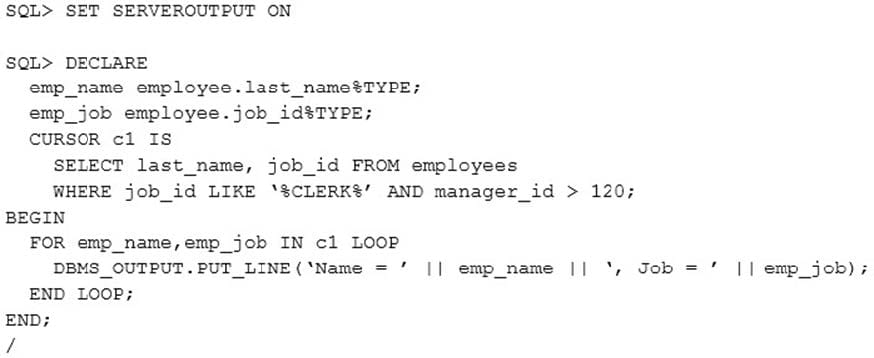Exam Details
Exam Code
:1Z0-144Exam Name
:Oracle Database 11g: Program with PL/SQLCertification
:Oracle CertificationsVendor
:OracleTotal Questions
:106 Q&AsLast Updated
:Aug 06, 2025
Oracle Oracle Certifications 1Z0-144 Questions & Answers
-
Question 11:
View the Exhibit to examine the PL/SQL code.

SERVEROUTPUT is on for the session.
Which statement is true about the execution of the code?
A. The execution fails because of the misplaced else clause.
B. The execution is successful even if there is no employee with EMPLOYEE_ID 115.
C. The execution fails and throws exceptions if no employee with EMPLOYEE_ID 115 is found.
D. The execution is successful, but it displays an incorrect output if no employee with EMPLOYEE_ID 115 is found.
-
Question 12:
Which statements correctly describe the features of functions and procedures? (Choose two.)
A. A procedure can contain a RETURN statement without a value.
B. A function can return multiple values using a single RETURN clause.
C. A procedure can be executed as part of a SQL expression or as a PL/SQL statement.
D. A function can contain zero or more parameters that are transferred from the calling environment.
-
Question 13:
Examine the following PL/SQL code; The execution of the code produces errors. Identify the error in the code.

A. The OPEN cursor is missing.
B. The FETCH clause is missing.
C. The EXIT WHEN condition is missing.
D. The EMP_NAME and EMP_JOB variables cannot be used in the for clause of the cursor FOR statement.
-
Question 14:
Examine the following PL/SQL code:

Which statement is true about the execution of the PL/SQL code?
A. It executes successfully.
B. It generates a run-time exception.
C. It does not execute because of syntax error.
D. It executes successfully and generates a warning.
-
Question 15:
View the Exhibit and examine the package code created by SCOTT. The execute privilege on this package is granted to GREEN.

Examine the following sequence of commands issued by SCOTT:

What is the outcome?
A. SCOTT'S session displays 5, and then 0, GREEN'S session displays 0.
B. SCOTT'S session displays 5, and then 0, GREEN'S session displays 5.
C. SCOTT'S session displays 5, and then 5, again, GREEN'S session displays 0.
D. SCOTT'S session displays 5, and then 5, again; GREEN'S session displays 5.
-
Question 16:
Which two statements are true about the EXIT statement encountered in LOOP? (Choose two.)
A. The PL/SQL block execution terminates immediately after the EXIT statement.
B. The loop completes immediately and control passes to the statement after END LOOP.
C. The statements after the EXIT statement in the iteration are not executed before terminating the LOOP.
D. The current iteration of the loop completes immediately and control passes to the next iteration of the loop.
-
Question 17:
Which two statements are true about database triggers? (Choose two.)
A. Each trigger can be of any size.
B. Each trigger can be of a maximum size of 32 KB.
C. A trigger can contain a maximum of 32 lines of code.
D. Triggers fired by DML statements cannot cascade simultaneously.
E. Both DML and DDL statements can cascade any number of triggers.
F. Both data manipulation language (DML) and data definition language (DDL) statements can cascade up to 32 triggers.
-
Question 18:
You execute the following block of code: Which statement is true about the outcome?

A. Both output statements show different values.
B. Both output statements show exactly the same values.
C. It gives an error because the nested blocks are not labeled.
D. It gives an error because the V_CUSTOMER variable cannot have different types in the nested blocks.
-
Question 19:
Which three statements are true about wrapping? (Choose three.)
A. The PL/SQL wrapper detects and reports only syntactic errors.
B. The PL/SQL wrapper detects and reports both syntactic and semantic errors.
C. When wrapping a package or object type, both the body and specification should be wrapped.
D. When wrapping a package or object type, only the body should be wrapped, not the specification.
E. To change a wrapped object, the original source code needs to be modified and then wrapped again.
F. To change a wrapped object, the wrapped code can be unwrapped, modified in a text file, and then wrapped again.
-
Question 20:
Which statements are true about database triggers? (Choose two.)
A. They can invoke only PL/SQL procedures.
B. They can include SQL and PL/SQL or calls to Java procedures.
C. They are implicitly fired by an event that must occur within an application.
D. They are implicitly fired when a triggering event occurs, depending on which user is connected.
Related Exams:
1Z0-020
Oracle8i: New Features for Administrators1Z0-023
Architecture and Administration1Z0-024
Performance Tuning1Z0-025
Backup and Recovery1Z0-026
Network Administration1Z0-034
Upgrade Oracle9i/10g OCA to Oracle Database OCP1Z0-036
Managing Oracle9i on Linux1Z0-041
Oracle Database 10g: DBA Assessment1Z0-052
Oracle Database 11g: Administration Workshop I1Z0-053
Oracle Database 11g: Administration II
Tips on How to Prepare for the Exams
Nowadays, the certification exams become more and more important and required by more and more enterprises when applying for a job. But how to prepare for the exam effectively? How to prepare for the exam in a short time with less efforts? How to get a ideal result and how to find the most reliable resources? Here on Vcedump.com, you will find all the answers. Vcedump.com provide not only Oracle exam questions, answers and explanations but also complete assistance on your exam preparation and certification application. If you are confused on your 1Z0-144 exam preparations and Oracle certification application, do not hesitate to visit our Vcedump.com to find your solutions here.